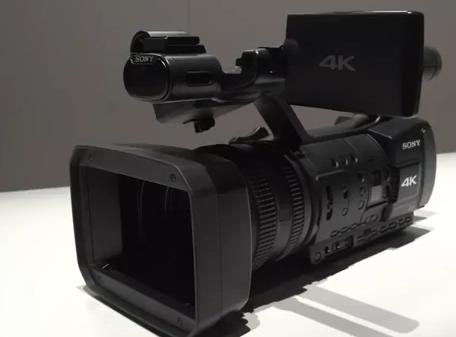Sony wants to bring 4K production to the masses
As it has done several times before in its history, Sony is looking beyond the Hollywood production community for its new 4K-capable production equipment — which includes cameras, switchers, record decks and monitors — and will now begin targeting the production mainstream — that is, rank-and-file videographers, small broadcast news stations and others looking for improved image quality but not wanting to give up their well-established workflows. Among a range of possibilities, that means smaller sized, ENG-style cameras that are instantly familiar to those working in HD today.

An affordable (sub-$6000) 4K camera for news? You’ve got my attention.
With 3DTV now a recent memory in the company’s history, the new strategy includes the notion that broadcasters can make 4K profitable and viewers with 3840 x 2160 (QFHD) resolution TV sets happy. Many say that a 1080 signal on a large-sized screen begins to look soft and highlights many of the broadcast imperfections (artifacts). Suddenly, or so the theory goes, we can’t live without big 4KTV sets.
To start with, Sony product managers say that a 4K camera makes a better HD picture than a dedicated high-definition camera, which Sony has seen good revenue from and which it continues to sell in large, albeit it shrinking, quantities. It is also bringing the price of such cameras down to a level that will make it hard not to choose a new 4K model over an existing HD camera. (Remember, 4K cameras can be used to shoot HD pictures as well.)
Like the move from SD to HD before it, if 4K begins to offer more value for the same or similar pricing, it would appear to make sense for someone to buy 4K instead. Pricing and advanced feature sets are usually the way to get the industry to migrate to a next-generation technology.
There’s even a new compression coded called XAVC, which looks at every frame of video before processing, for better results than the existing AVC algorithms.
Then there’s the claim that consumers like 4KTV. One executive told me that Sony has sold nearly 1000 80in LCD 4K TVs for $25,0000 each. Set sizes of 55in are now being sold for $5000 and are “selling well.”
The professional video industry's #1 source for news, trends and product and tech information. Sign up below.
So, the idea is to support the thousands of professionals that use video, houses of worship, museums, medical facilities, military and government agencies with equipment they can actually afford. Consumers and retails businesses, as well, can now afford a 4K-capable set.
Sony executives predict it will take about three to five years before a significant amount of compatible sets are in consumers’ living rooms and the average IMAG application is displayed in 4K. They also say that 8K and 16K would lead to even better images, but the business model for such high-resolution workflows is just not practical. Thus, while some will experiment with the technology (NHK in Japan has announced live broadcast testing will begin in 2016), these will be mere “science experiments.”
“In the U.S., 4K has now become a familiar subject of discussion, and we are hoping that our new-generation production equipment will accelerate that conversation,” said Tatsuro Kurachi, Director, Product Marketing & Management, Professional Solutions of America, at Sony. “However, in some regions of the world, they are just opening up to HD production, so it makes sense for Sony to continue to deliver HD equipment. But for the U.S., we think people will begin to see the value of 4K and say that this will be my next investment, not an HD camera.”
Of course, let’s not loose sight of the fact that tape-based HDV cameras are still good sellers in third-world countries, and Sony is happy to support them.
It used to be that companies like Sony would rely heavily on celebrity users (basically giving them free access to gear) to market their products. With numerous TV shows and even more pilots now being shot with Sony F65 4K cameras, that market, for Sony, is well established. Now if it can only convince that steadily working event videographer to experiment with the improved image quality of 4K — perhaps helping his business increase — then sales will improve across the board and 4K will become the next de facto standard for video production.
It’s a tough row to hoe, but Sony’s appears willing to commit significant resources to reaping the 4K fruits of its labors.
